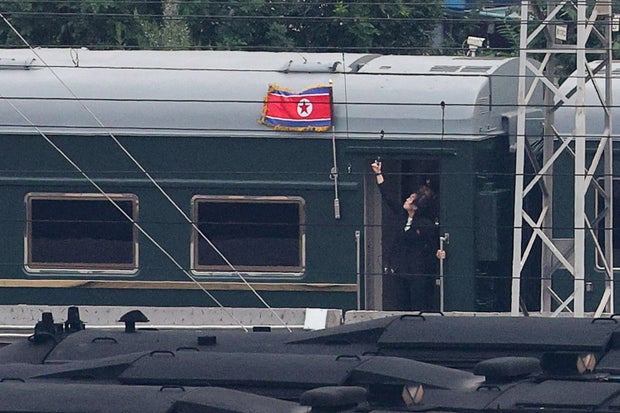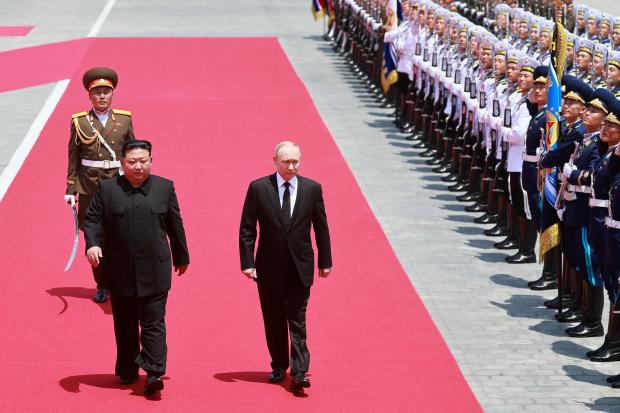Beijing — China will host its biggest military parade ever on Wednesday, to commemorate the 80th anniversary of the end of World War II and Japan’s formal surrender. The massive procession will go down Chang-an Avenue, the name of which means “Eternal Peace.”
Joining Chinese Prime Minister Xi Jinping for the “Victory Day” event — which will showcase some of China’s newest and most advanced weapons — will be Russia’s Vladimir Putin and North Korea’s Kim Jong Un.
Rehearsals have been underway for weeks, and security in the sprawling Chinese capital has been extra tight. All buildings overlooking the parade route will be locked down as the leaders and other dignitaries from 26 countries take in the spectacle, along with some 50,000 spectators.
For China’s 72-year-old leader Xi, it will be a landmark moment. It’s the third and most important military parade he will have overseen since coming to power in 2012. As commander-in-chief of the world’s largest standing armed forces, he will watch as tens of thousands of troops under his orders march toward Tiananmen Square in central Beijing.
Tingshu Wang/REUTERS
It will be a visceral display not only of China’s growing military might and newest hardware, including hypersonic weapons, nuclear capable missiles, fighter jets and underwater drones, but of its growing clout as a geopolitical power, with deepening ties to some of the United States’ most potent adversaries.
North Korea’s Kim arrived in Beijing Tuesday aboard his green armored train, stopping to inspect one of his own country’s missile production facilities on the way before crossing into China.
The parade will be the first time that Kim appears together with both Xi and Putin — offering him a first multilateral diplomatic event.
Go Nakamura/REUTERS
The symbolism of the three leaders together on a stage with Xi’s military thundering past in formation will be undeniable. Xi is expected to be flanked by Putin and Kim. Together, they have been dubbed an “Axis of Upheaval” by some Western analysts.
Xi is bringing together the leaders of some of the most heavily sanctioned nations in the world. Iran‘s President Masoud Pezeshkian and the leader of Myanmar’s ruling military junta, President Min Aung Hlaing will also be attending, according to China’s Ministry of Foreign Affairs.
It is a clear show of solidarity against the West, and it’s being seen as a direct challenge to the U.S.-led world order that has prevailed for a century. Xi and Putin have made their ambition to shake up that status quo clear for at least several years.
Sputnik/Alexander Kazakov/Pool/REUTERS
“We, together with you and with our sympathizers, will move towards a multipolar, just, democratic world order,” Russia’s longtime Foreign Minister Sergey Lavrov said in 2022, ahead of a meeting with his Chinese counterpart.
The gathering in Beijing will make represent a clear challenge to President Trump’s claim to be fostering close working relationships with Xi, Putin and Kim. Xi’s bond with Putin was on clear and deliberate display in the days leading up to the parade.
China and Russia have declared their “no limits partnership,” and while China claims to maintain a neutral stance on Russia’s war in Ukraine, Beijing’s support of the war effort — by providing dual-use technology and continuing to purchase Russian oil and gas in defiance of Western sanctions, has proven to be an economic lifeline funding Putin’s three and a half year war.
During talks at Beijing’s Great Hall of the People on Tuesday, Putin hailed “unprecedentedly high relations” with China and thanked his “dear friend” Xi for the warm welcome.
Kim’s support for Russia’s war has been even more direct. Since October last year, North Korea has sent around 13,000 troops, along with conventional weapons, to support Russia’s war effort. South Korea’s intelligence services estimate that around 2,000 North Korean troops have been killed fighting alongside Russian forces.
GAVRIIL GRIGOROV/POOL/AFP/Getty
The parade will be a show of both China and Russia’s implicit support for Kim’s nuclear weapons program, which remains the subject of numerous United Nations sanctions.
Xi burnished his credentials as a geopolitical powerbroker at a regional security summit in Tianjin, northern China, that ended on Monday. He hosted more than 20 world leaders there, including Putin and Indian Prime Minister Narendra Modi.
“We should uphold fairness and justice,” Xi declared at the gathering of the Shanghai Corporation Organization, seemingly trying to claim moral high ground amid the upheaval and strained relationships caused by President Trump’s global trade war and isolationist policies. “We must oppose the Cold War mentality, block confrontation and bullying practices.”
Without mentioning the U.S. or its president by name, Xi told the assembled leaders of non-Western countries: “We must continue to take a clear stand against hegemonism and power politics.”
Suo Takekuma/Pool/Getty
On Monday Xi, Putin and Modi were shown together smiling and laughing at the summit — a deliberate public display of warmth and camaraderie. Just last week, the U.S. imposed 50% tariffs on India for buying Russian oil.
U.S. Treasury Secretary Scott Bessent, a close ally of Mr. Trump, called the summit “performative” and accused China and India of being “bad actors” for fueling Russia’s war.
At the parade this week, Xi is not only asserting China as a reliable and stable partner, but also showing off his country’s burgeoning alliances, influence and its military might and power. It is a message that many will see as being aimed squarely, if not entirely, at China’s rival across the Pacific.
contributed to this report.




